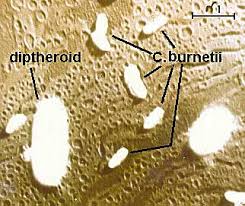Q QUERY fever homeopathic treatment

Coxiella burnetii is a species of intracellular, pathogenic bacteria, and is the causative agent of Q fever. The genus Coxiella is morphologically similar to the rickettsia, but with a variety of genetic and physiological differences. C. burnetii are small Gram negative bacteria with two growth phases, as well as a spore form which lies idle in soil. It can survive standard disinfectants, and is resistant to many other environmental changes like those presented in the phagolysosome.
Q fever is an infection caused by Coxiella burnetii, a type of bacterium found worldwide except New Zealand. The infection is almost always related to direct or indirect contact with animals such as cattle, sheep or goats, although a wide range of animals including cats, dogs and kangaroos may carry the infection. Infection in animals is probably common, but animals usually do not appear to be ill.
The bacteria pass into milk, urine and faeces of infected animals and during birthing, large numbers of organisms are shed in the birth products. Q fever organisms are resistant to heat, drying and many common disinfectants, allowing them to survive for long periods in the environment.
Infection of humans usually occurs by inhalation of the bacteria in air carrying dust contaminated by dried placental material, birth fluids, urine or faeces of infected herd animals. Contaminated clothing, wool, hides or straw may also be a source of infection. Person-to-person spread is extremely unlikely. Usually, Q fever is an occupational disease of meat workers, farmers and veterinarians (vets). People living within 1 kilometre downwind of an abattoir are also at increased risk of infection.